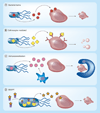Potent and tumor specific: arming bacteria with therapeutic proteins
- PMID: 25853312
- PMCID: PMC4423202
- DOI: 10.4155/tde.14.113
Potent and tumor specific: arming bacteria with therapeutic proteins
Abstract
Bacteria are perfect vessels for targeted cancer therapy. Conventional chemotherapy is limited by passive diffusion, and systemic administration causes severe side effects. Bacteria can overcome these obstacles by delivering therapeutic proteins specifically to tumors. Bacteria have been modified to produce proteins that directly kill cells, induce apoptosis via signaling pathways, and stimulate the immune system. These three modes of bacterial treatment have all been shown to reduce tumor growth in animal models. Bacteria have also been designed to convert nontoxic prodrugs to active therapeutic compounds. The ease of genetic manipulation enables creation of arrays of bacteria that release many new protein drugs. This versatility will allow targeting of multiple cancer pathways and will establish a platform for individualized cancer medicine.
Conflict of interest statement
The authors have no other relevant affiliations or financial involvement with any organization or entity with a financial interest in or financial conflict with the subject matter or materials discussed in the manuscript apart from those disclosed.
No writing assistance was utilized in the production of this manuscript.
Figures



References
-
- Minchinton AI, Tannock IF. Drug penetration in solid tumours. Nat. Rev. Cancer. 2006;6(8):583–592. - PubMed
-
- Jain RK. The next frontier of molecular medicine: delivery of therapeutics. Nat. Med. 1998;4(6):655–657. - PubMed
-
- Kasinskas RW, Forbes NS. Salmonella typhimurium specifically chemotax and proliferate in heterogeneous tumor tissue in vitro. Biotechnol. Bioeng. 2006;94(4):710–721. - PubMed
Publication types
MeSH terms
Substances
Grants and funding
LinkOut - more resources
Full Text Sources
Other Literature Sources
